How to Stop Junk Mail
Sometimes it feels like the only snail mail you get is junk mail. The amount of junk mail hitting US mailboxes every day is staggering, with the average US household receiving 800+ pieces of junk mail each year. Stopping unsolicited mail from flooding your mailbox is easier than you might think—at least with the right advice.
What is junk mail? We’ll consider any unwanted mail as junk for the purposes of this guide. This includes bulk mail, direct mail, and direct marketing mail. You’ll end up sorting your junk mail into these categories: unwanted catalogs will need a different approach than prescreened credit offers, for example.
There’s a special category of mail that’s addressed to a former tenant, owner, or some random person you’ve never heard of. Returning it to the sender is a solid goal, but it’s not always an option and, even when it is, you have to get the wording just right to have the desired effect. Read on to learn how.
Updated: September 29, 2023
In short:
- Stop as much as 80% of direct marketing mail by registering with DMAchoice.org.
- Remove your contact info from data brokers.
- Stop junk mail sent out by other direct mail companies.
- Stop prescreened offers.
- Stop catalog and coupon spam.
- Stop sweepstakes spam.
- Contact each organization to unsubscribe from junk mail you’ve actually signed up for.
- Stop mail that’s not even addressed to you.
Keep reading to learn how.
Stop as much as 80% of direct marketing mail by registering to DMAchoice.org
The Data and Marketing Association (DMA) is likely responsible for the lion’s share of the direct marketing offers in your mailbox. At least it is in most areas, accounting for about 80% of all direct marketing mail nationwide. Luckily, the DMA offers an opt-out service to get your address off its mailing lists.
- Go to DMAchoice.org and register.
- Pay the $4 administrative fee (using a credit card or PayPal).
- Enjoy a drastic reduction in direct marketing mail for 10 years.
Alternatively, you can fill and mail in a registration form together with a $5 check or money order payable to ANA. This will cover the same 10-year registration period.
DMA Choice also offers tools to help consumers opt out the deceased, opt out as caretakers, and register for the Pennsylvania and Wyoming do-not-call lists. It also has an email opt-out service that can help to reduce the volume of unsolicited commercial email you receive. Read about how to opt out of marketing associations and AdChoices here.
Read on to see how you can strike at the root causes of not only junk mail but also spam email and even robocalls.
Remove your contact info from data brokers
The important thing to realize is that all these direct marketers and other purveyors of unsolicited advertising have to get your personal information from somewhere. It’s generally not worth their while to build a mailing list from scratch, so they make use of middle men.
These middle-men companies are known as data brokers and they specialize in crawling and scraping the internet for your personal and consumer information. They also exchange hundreds of millions of consumer profiles among themselves, like kids swapping trading cards to round out their collections.
As long as your personal data is doing the rounds with these companies, it’ll continue to resurface somewhere. Prescreened credit and bank offers are probably the mildest side effects of having your personal information bought, sold, and traded by these data brokers.
Some data brokers, called people search sites, will publish most if not all of your personal data for free. Even those data brokers that place access to full profiles and “background checks” behind a paywall will often have trial memberships for as little as $1, meaning that essentially anyone can look you up.
These profiles include everything direct marketers need to target you with junk mail, like your name and address. But that’s just the tip of the iceberg. They can include information as sensitive as your Social Security Number and court and property records.
Rather than just leading to more credit card offers and donation requests, having your information in the hands of data brokers increases your chances of falling victim to credit card fraud and even identity theft. It also makes it much easier for online trolls to doxx you and stalkers to invade your privacy.
You’ve seen how much time and effort it takes to stem the flow of junk mail. That’s nothing compared to what you’d have to go through to opt out of the hundreds of data brokers known to operate in the US. It’d take you an estimated 304 hours just to complete the first round of opt-out requests.
Incogni’s automated personal information removal service does all this and more for you, all you have to do is sign up and sit back. Incogni will figure out which data brokers are most likely to hold your personal data and then automatically send out wave after wave of opt-out requests, restarting the whole process every three months to make sure your personal information stays private.
Stop junk mail sent out by other direct mail companies
The DMA might be responsible for the largest chunk of junk mail in your letterbox, but it’s not the only culprit. CatalogChoice.org offers opt-out options similar to DMA Choice, but with two important differences: Catalog Choice is a free service and it gives you control over which junk mail you block and which you let through.
- Register on the Catalog Choice sign-up page.
- Follow the on-screen instructions to opt out of the junk mail you don’t want to receive anymore.
- Enjoy fine-grain control over what catalogs and other junk you do and don’t get.
Like DMA Choice (or any other method for reducing junk mail), Catalog Choice can’t get your junk mail count down to zero, but every little bit helps. That said, Catalog Choice covers 10,000+ titles. It might only be a small proportion of all the junk mail you receive, but it’s certainly nothing to sneeze at.
Stop prescreened offers
So-called prescreened offers of credit and insurance can be a real pain, especially at particular points in your life. You’ll notice these offers whipping up to fever pitch just after selling or purchasing property, for example.
The companies responsible for you getting these offers are Equifax, Experian, Innovis, and TransUnion. These data brokers are known as Consumer Credit Reporting Companies owing to their compliance with the Fair Credit Reporting Act (FCRA). This puts them in something of a special category among data brokers.
The good news is that you can opt out of all four companies’ databases through a single opt-out procedure. The bad news is that it’s not the most user-friendly opt-out process out there. The OptOutPrescreen website gives you the chance to opt out of prescreened offers from these companies. Is optoutprescreen a legit site? We answered the question here.
This site gives you three options:
- Opt out of receiving credit and insurance offers for five years.
- Opt out of receiving credit and insurance offers permanently (requires you to mail in the Permanent Opt-Out Election form).
- Opt back into receiving these offers after having opted out.
We recommend that you complete the online form to opt out for five years while also mailing in a permanent opt-out request. This way you’ll be able to get the ball rolling as soon as possible, with the slower, mail-in process upgrading your opt out down the line. Here’s how:
- Go to the OptOutPrescreen.com selection screen and choose “electronic opt-out for 5 years”. Click “continue.”
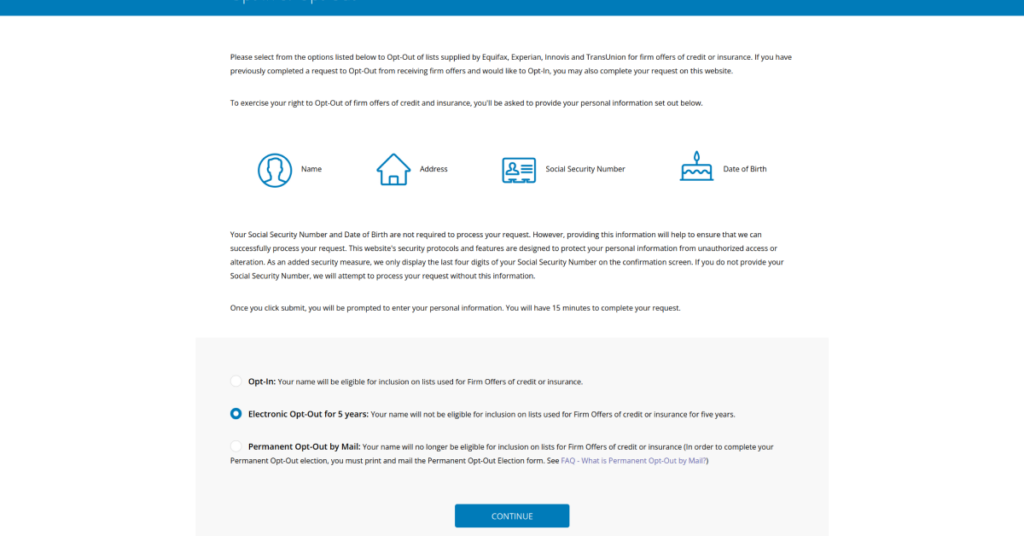
- Type in your first and last name and street address, complete the security challenge, and click “confirm.”
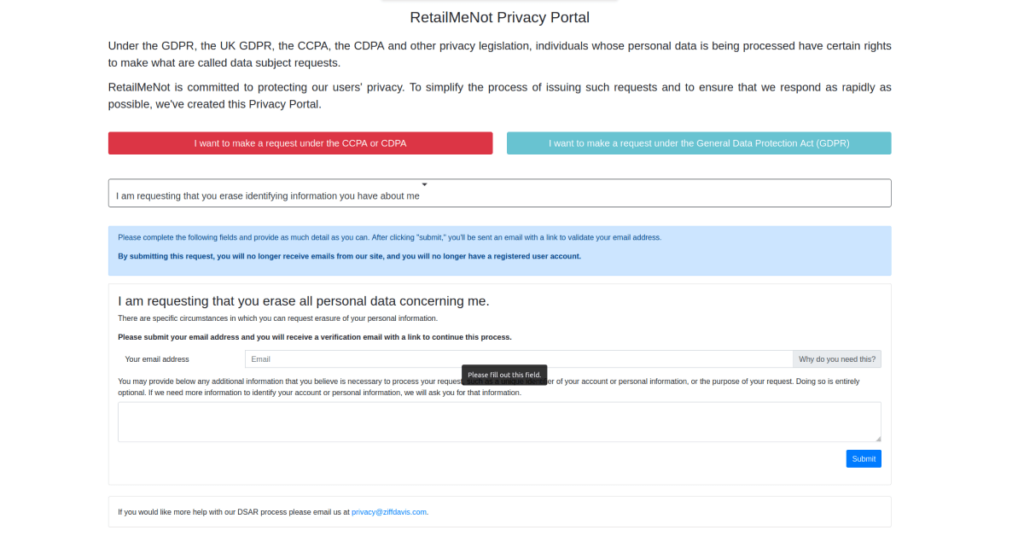

Once you’ve submitted your five-year opt-out request, go right back to that selection screen.
- This time choose “permanent opt-out by mail” and click “continue.”
- Once again, type in your first and last name and street address, complete the security challenge, and click “confirm.”
- On the confirmation screen, click on the link to print out both a confirmation of your opt-out request and the Permanent Opt-Out Election form itself.
- Post the Permanent Opt-Out Election form to:
Opt-Out Department
P.O. Box 530200
Atlanta, GA 30353
There are some very important caveats to keep in mind when dealing with these companies (they’re behind the OptOutPrescreen website too). The opt-out forms include fields for your Social Security number and date of birth. We strongly advise against giving any data brokers personal information like this.
Luckily, the SSN and DOB fields are optional and we recommend you leave them blank. This may lead to your opt-out request being rejected. In such cases, we recommend you contact OptOutPrescreen.com directly on 1-888-567-8688 (toll-free).
The other thing to keep in mind is that opting out of prescreened (or “firm”) offers with these major consumer reporting companies will not affect your credit score at all. If for any reason you want to start receiving offers again, simply complete the opt-in procedure on OptOutPrescreens.com.
Stop Catalog and coupon spam
When most people look into how to stop junk mail, they typically picture coupons and catalogs spilling out of their mailboxes or piling up at their doorstep. Like with every other type of junk mail, there’s no one silver-bullet solution that’ll stop everything.
DMA Choice and/or Catalog Choice should take care of most of the catalog and coupon spam cluttering your stoop. To get rid of the next biggest offenders among what’s left, target those Valpaks and RetailMeNot’s advertising mail.
– Valpak
Valpak, unfortunately, seems to only allow people to protect their data privacy when the law explicitly forces it to do so. So, there are separate opt-out pages for California and Nevada residents. Here’s how you can opt out if you live in either state:
- Go to the relevant opt-out page for your state (California or Nevada).
- Fill in your first and last name, email address, phone number, street address, city, and zip code, and click “send.”
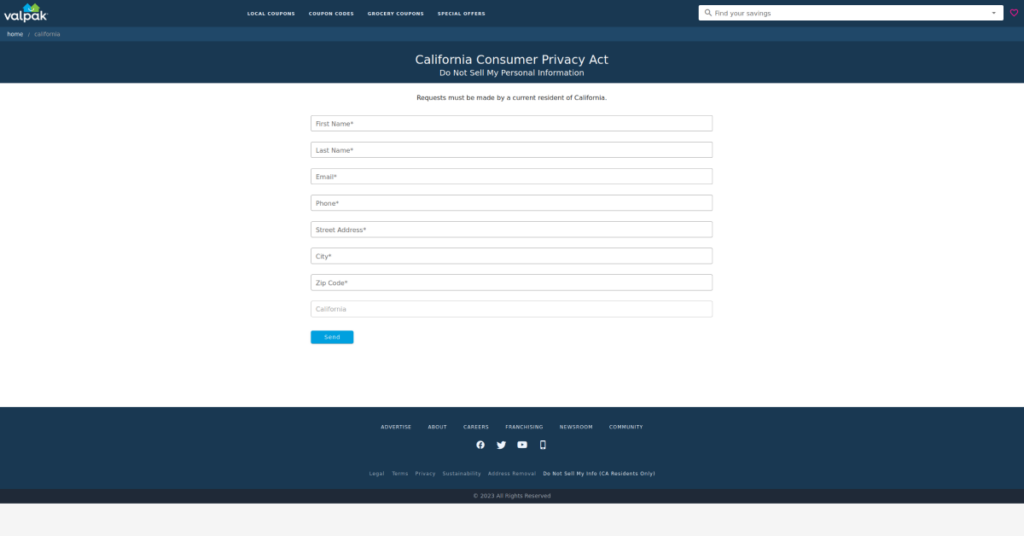

IMPORTANT: We strongly advise against providing companies like Valpak with any personal information they don’t already have. Valpak probably already has your name and street address, but it doesn’t necessarily have your email address and phone number. So mask your email address or use a throwaway account and provide a burner number. If you don’t have one yet, we reviewed disposable email services in this article.
– RetailMeNot
RetailMeNot (formerly RedPlum) also doesn’t appear to be going above and beyond to let you assert your right to privacy. Residents of California, Colorado, the UK, and the EU are in luck, though. Start the opt-out process by going to RetailMeNot’s “Privacy Portal.”
- Click on “I want to make a request under the CCPA or CDPA” if you’re a current resident of California or Colorado or on “I want to make a request under the General Data Protection Act (GDPR)” if you’re in the EU or UK.

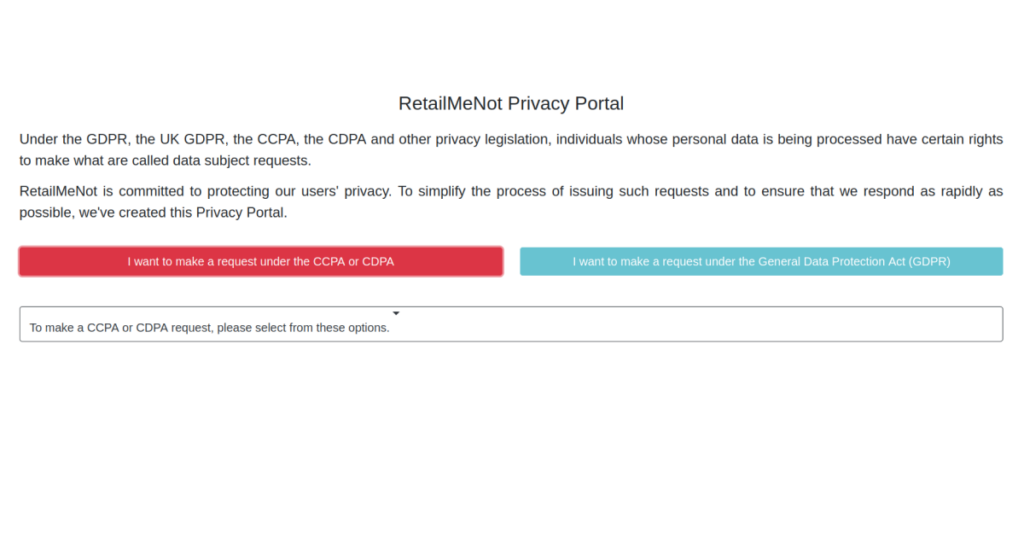
- Select “I am requesting that you erase identifying information you have about me.”
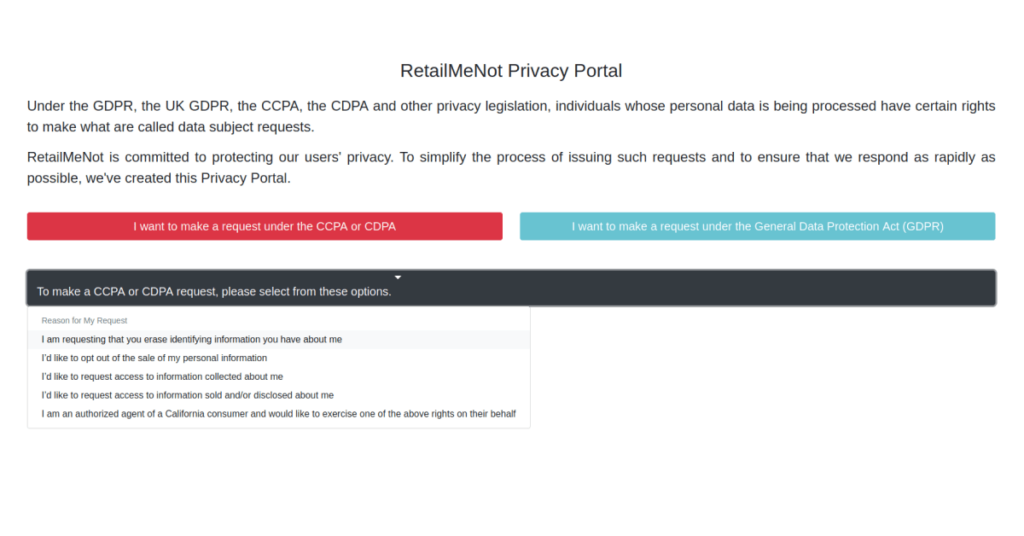
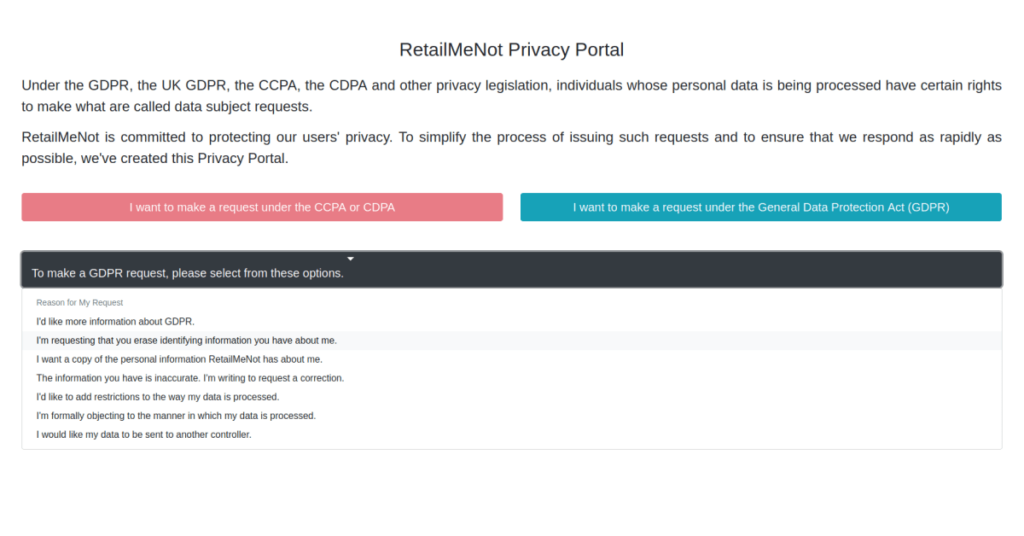
- Enter a throwaway or masked email address in the “your email address” field.
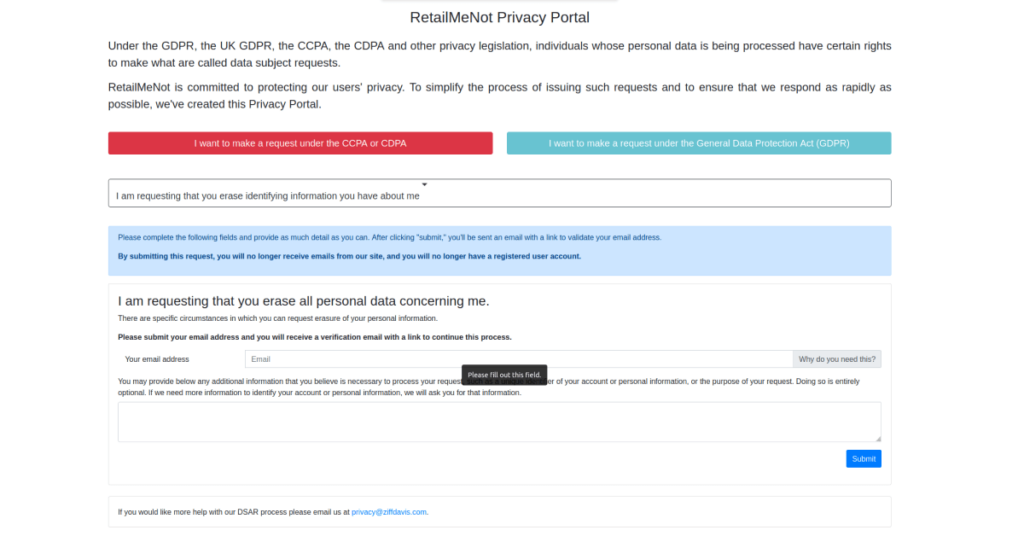
- Enter your street address in the “additional information” field.

Again, it’s very important that you don’t provide companies like this with personal details they don’t already have. RetailMeNot’s claim that it uses your email address to “authenticate your request” is suspect to say the least: if it doesn’t already have your email address on file, then how can it use it to authenticate anything?
Stop sweepstakes spam
Another kind of junk mail that springs readily to mind is sweepstakes spam. There are many companies out there organizing sweepstakes, but the Publishers Clearing House is probably the most common one you’ve been coming across. Here’s how to opt out of its mailing list:
- Go to the Publishers Clearing House (PCH) opt-out page.
- Type in your customer ID if you have one—it’s the eleven-digit number on your PCH invoice or order confirmation.
- Enter your first and last name and street address, do not provide a phone number.
- Click “submit.”

It’ll take PCH two business days to process your request and you should stop receiving PCH mailings about 6–8 weeks after that.
Contact each organization to unsubscribe from junk mail you’ve actually signed up for
If you define junk mail as any unwanted mailings that reach your mailbox, then you might include things you signed up for in the past and no longer want to receive. These can be store or product catalogs, magazine subscription offers, newsletters, charity drives, and so on.
Contact each organization to unsubscribe from further mailings. There should be some contact details somewhere on the material you received from them. You might need to do a little sleuthing online to find a website, email, contact phone number, or mailing address.
Even if there’s no set procedure for unsubscribing or opting out, it ought to be enough for you to make a request by whatever means available to you. Make it a written request, if possible, and keep a copy of your correspondence together with when and to whom you sent it.
Stop Mail that’s not even addressed to you
Again, although not exactly the typical retail promotions, magazine offers, or credit card offers that come to mind when you think about junk mail, it can be just as irritating to constantly receive mail that’s addressed to someone else.
Whether a former tenant, property owner, or someone who you’ve got no idea who they are, you can’t legally destroy or interfere with their mail. Instead, write “not at this address” on the envelope and put it in with your outgoing mail. Don’t cross out the recipient’s name or any part of your address.
Do not write “return to sender” in addition to or instead of “not at this address.”
Return to sender—when is it an option?
You might come across advice to just write “return to sender” on unsolicited mail and other mail that you’ve come to consider junk and cram it into your outgoing mail. However satisfying this might be, it’s often not the way to go. You’ve already seen how it’s not the solution when you receive junk mail addressed to a previous resident.
Mail that’s addressed to you
To refuse most kinds of mail, including most packages, simply write “refused” above or near your address and hand it back to your mail carrier or put it in with your outgoing mail. This only works for unopened packages. Sometimes, you’ll only be able to refuse mail at the point of delivery, sometimes at or after delivery.
You could also write “refused: return to sender,” but USPS will already try to return refused mail to its sender by default.
Wrong delivery address
What if you get mail that’s been delivered to your address by mistake? Simply put it straight back into your mailbox and flip the red flag up—your mail carrier will pick it up next time and handle it from there. Do not write anything on the envelope or package. Writing “return to sender” is not the right option here.
Junk mail addressed to no one in particular
This is where “return to sender” can really come into its own: junk mail addressed to “the occupant,” “the resident,” “the homeowner,” “our neighbors,” and so on. It’s not a cure-all, though—check for these phrases:
- Return service requested
- Forwarding service requested
- Change service requested
- Address service requested
- First Class Mail.
If you find at least one of the above, write “refused” or “refused: return to sender” on the envelope and put it with your outgoing mail.
Unstoppable junk mail
There’s some junk mail you’ll probably never be able to stop. Luckily, it’s usually only a tiny proportion of all the spam in your mailbox. Leaflets, flyers, circulars, catalogs, and anything else that’s hand-delivered to every address in an area are immune to all of the above methods.
There are no mailing lists involved, the US Postal Service has nothing to do with it, and there’s no marketing association to approach. All you can do is put up a tasteful sign or plaque (the classic “no junk mail please” will do) and have a friendly chat with the leaflet carriers if you get the chance.
Again, if you follow the advice above, you’ll end up with only a tiny amount of leftover spam mail. The odd hand-delivered, small-scale leafleting campaign will be a world apart from what you’re dealing with now.
More guides on how to stop spam:
- How to unsubscribe from emails on Gmail in bulk
- How to block texts from emails
- How to stop spam emails in Gmail
- How to stop getting emails from Reddit
- How to clear your Gmail inbox
- How to delete multiple emails in Gmail on phone
- How to delete all promotions in Gmail
- How to delete multiple emails on Android
- How to block an email address
- How to stop spam emails on iPhone
- “I accidentally opened a spam email”—now what?